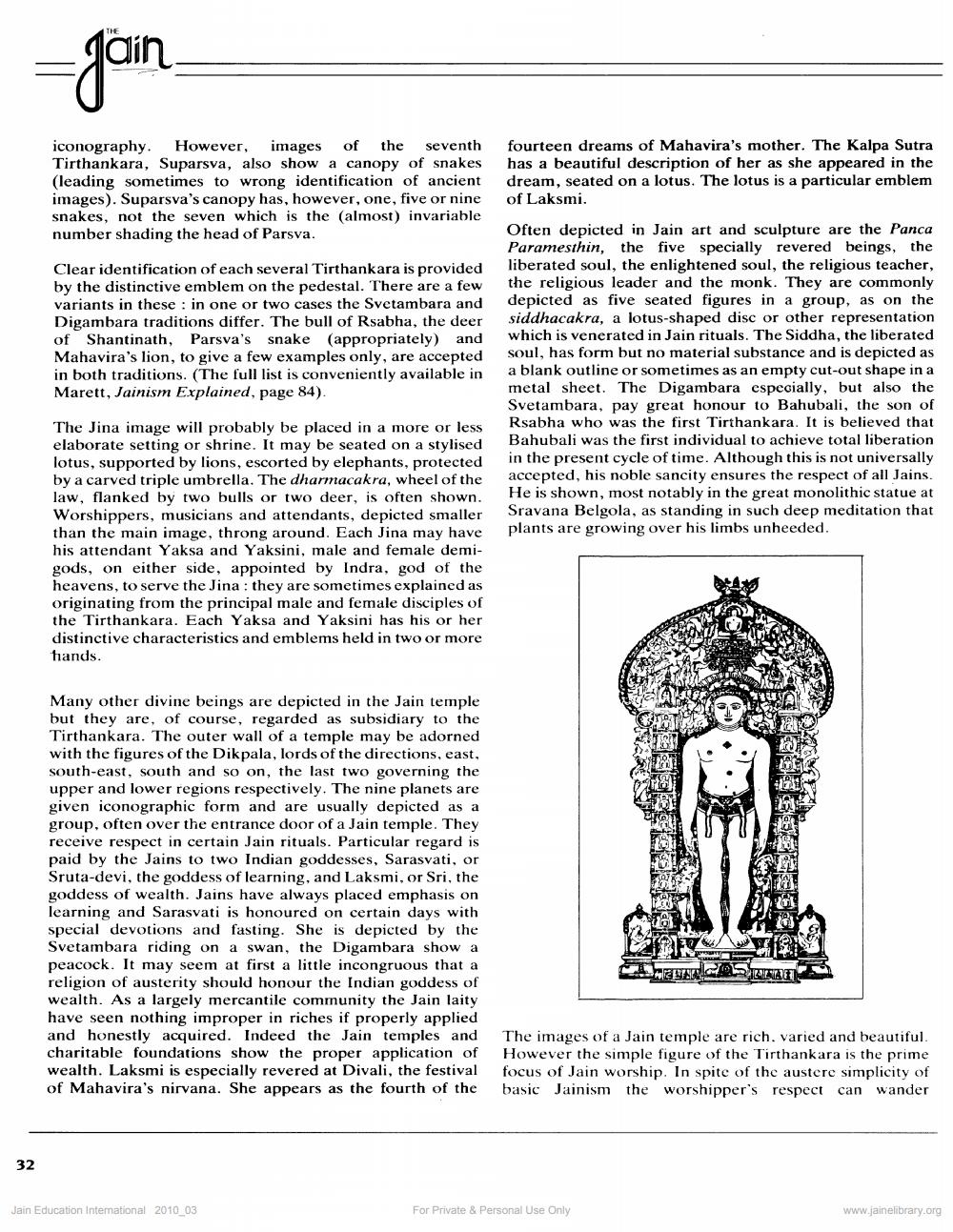________________
iconography. However, images of the seventh Tirthankara, Suparsva, also show a canopy of snakes (leading sometimes to wrong identification of ancient images). Suparsva's canopy has, however, one, five or nine snakes, not the seven which is the (almost) invariable number shading the head of Parsva.
fourteen dreams of Mahavira's mother. The Kalpa Sutra has a beautiful description of her as she appeared in the dream, seated on a lotus. The lotus is a particular emblem of Laksmi.
Clear identification of each several Tirthankara is provided by the distinctive emblem on the pedestal. There are a few variants in these : in one or two cases the Svetambara and Digambara traditions differ. The bull of Rsabha, the deer of Shantinath, Parsva's snake (appropriately) and Mahavira's lion, to give a few examples only, are accepted in both traditions. (The full list is conveniently available in Marett, Jainism Explained, page 84).
Often depicted in Jain art and sculpture are the Panca Paramesthin, the five specially revered beings, the liberated soul, the enlightened soul, the religious teacher, the religious leader and the monk. They are commonly depicted as five seated figures in a group, as on the siddhacakra, a lotus-shaped disc or other representation which is venerated in Jain rituals. The Siddha, the liberated soul, has form but no material substance and is depicted as a blank outline or sometimes as an empty cut-out shape in a metal sheet. The Digambara especially, but also the Svetambara, pay great honour to Bahubali, the son of Rsabha who was the first Tirthankara. It is believed that Bahubali was the first individual to achieve total liberation in the present cycle of time. Although this is not universally accepted, his noble sancity ensures the respect of all Jains. He is shown, most notably in the great monolithic statue at Sravana Belgola, as standing in such deep meditation that plants are growing over his limbs unheeded.
The Jina image will probably be placed in a more or less elaborate setting or shrine. It may be seated on a stylised lotus, supported by lions, escorted by elephants, protected by a carved triple umbrella. The dharmacakra, wheel of the law, flanked by two bulls or two deer, is often shown. Worshippers, musicians and attendants, depicted smaller than the main image, throng around. Each Jina may have his attendant Yaksa and Yaksini, male and female demigods, on either side, appointed by Indra, god of the heavens, to serve the Jina : they are sometimes explained as originating from the principal male and female disciples of the Tirthankara. Each Yaksa and Yaksini has his or her distinctive characteristics and emblems held in two or more hands.
Ger
Many other divine beings are depicted in the Jain temple but they are, of course, regarded as subsidiary to the Tirthankara. The outer wall of a temple may be adorned with the figures of the Dikpala, lords of the directions, east, south-east, south and so on, the last two governing the upper and lower regions respectively. The nine planets are given iconographic form and are usually depicted as a group, often over the entrance door of a Jain temple. They receive respect in certain Jain rituals. Particular regard is paid by the Jains to two Indian goddesses, Sarasvati, or Sruta-devi, the goddess of learning, and Laksmi, or Sri, the goddess of wealth. Jains have always placed emphasis on learning and Sarasvati is honoured on certain days with special devotions and fasting. She is depicted by the Svetambara riding on a swan, the Digambara show a peacock. It may seem at first a little incongruous that a religion of austerity should honour the Indian goddess of wealth. As a largely mercantile community the Jain laity have seen nothing improper in riches if properly applied and honestly acquired. Indeed the Jain temples and charitable foundations show the proper application of wealth. Laksmi is especially revered at Divali, the festival of Mahavira's nirvana. She appears as the fourth of the
DA SE
the images of a Jain temple are rich. varied and beautiful. However the simple figure of the Tirthankara is the prime focus of Jain worship. In spite of the austere simplicity of basic Jainism the worshipper's respect can wander
32
Jain Education Interational 2010_03
in Education Intermational 2010_03
For Private & Personal Use Only
Fo
www.jainelibrary.org




